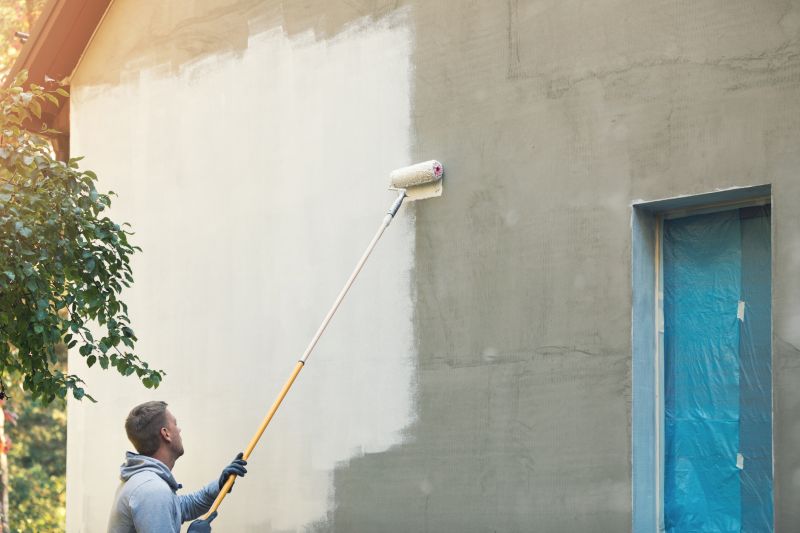Ultimate Collection Of Products For Stucco Wall Paintings
Find out which key supplies and tools are considered must-haves for producing impressive stucco wall paintings.
 Creating stunning stucco wall paintings involves selecting the right products that can adhere well to textured surfaces and withstand the test of time. The process often requires specialized paints, primers, and finishing materials designed specifically for stucco or similar textured wall surfaces. These products help enhance the visual appeal of murals and decorative artworks, providing a durable and attractive finish. When choosing products for stucco wall paintings, it's important to consider their compatibility with the surface texture, ease of application, and longevity. Many artists and decorators prefer versatile options that can be applied with various tools such as brushes, rollers, or spray equipment to achieve the desired artistic effect.
Creating stunning stucco wall paintings involves selecting the right products that can adhere well to textured surfaces and withstand the test of time. The process often requires specialized paints, primers, and finishing materials designed specifically for stucco or similar textured wall surfaces. These products help enhance the visual appeal of murals and decorative artworks, providing a durable and attractive finish. When choosing products for stucco wall paintings, it's important to consider their compatibility with the surface texture, ease of application, and longevity. Many artists and decorators prefer versatile options that can be applied with various tools such as brushes, rollers, or spray equipment to achieve the desired artistic effect.
Top Overall Option
High-Quality Acrylic Wall Paint for Stucco
This versatile acrylic wall paint is designed to adhere well to textured stucco surfaces, providing a durable and vibrant finish. It offers excellent coverage, easy application, and good flexibility to accommodate the natural expansion and contraction of stucco walls. Suitable for both artistic murals and decorative accents, it can be applied with brushes, rollers, or spray equipment. Its quick-drying formula and resistance to cracking make it a preferred choice for long-lasting wall art projects.
Types of Products For Stucco Wall Paintings
Acrylic Wall Paints
Water-based paints suitable for vibrant murals and detailed artwork on stucco surfaces.
Latex Exterior Paints
Durable paints designed for outdoor stucco walls, offering weather resistance and flexibility.
Stucco-Specific Textured Paints
Paints formulated to enhance or match the existing texture of stucco walls for seamless integration.
Primer for Textured Walls
Specialized primers that prepare rough surfaces for better paint adhesion and longevity.
Sealers and Clear Coats
Protective finishes that safeguard murals from moisture, UV rays, and cracking.
Spray Paints for Stucco
Aerosol options for quick coverage and creative effects on textured surfaces.
Texturing Tools and Rollers
Tools that help create unique patterns and textures on painted stucco walls.
Stencils for Textured Walls
Pre-cut designs that assist in adding intricate details to murals on uneven surfaces.
Epoxy Coatings
Heavy-duty coatings for enhanced durability and chemical resistance on stucco murals.
Chalk and Pastel Art Supplies
Materials suitable for preliminary sketches or detailed artwork on textured walls.
Varnishes and Finishing Products
Products that add gloss or matte effects while protecting the painted surface.
Popular Choices
Widely used for their ease of application and range of colors suitable for stucco murals.
Commonly chosen for outdoor stucco murals due to their weather-resistant properties.
Popular for matching or enhancing the natural texture of stucco surfaces.
Essential for preparing rough surfaces to improve paint adhesion and durability.
Frequently used to extend the lifespan of murals and protect against environmental damage.
Favored for quick coverage and creating effects on textured walls.
Popular for adding detailed designs and patterns to stucco murals.
Commonly used to create consistent textures and artistic effects.
Chosen for finishing murals with a protective and aesthetic layer.
Ideal for fine details and touch-ups on textured wall surfaces.
Selected for high durability and chemical resistance in high-traffic or outdoor areas.
Popular for temporary murals or preliminary sketches on stucco walls.
Stucco walls pose unique challenges due to their rough and uneven surface, which can affect paint adhesion and overall appearance. Therefore, selecting high-quality primers that can seal and prepare the surface is a crucial first step. Once the surface is adequately prepared, artists can choose from a range of paints, including acrylics, latex, or specialty stucco paints, each offering different finishes and textures. Finishing products like sealers or clear coats can further protect the artwork from cracking, fading, or moisture damage, ensuring the mural remains vibrant over time.
In addition to paints and primers, tools such as textured rollers, sponges, and spray guns can be employed to create unique effects on stucco surfaces. Some products are formulated to work seamlessly with these tools, allowing for more creative freedom. For detailed or intricate designs, artists may opt for fine brushes or stencil kits designed specifically for textured walls. Overall, the key to successful stucco wall paintings lies in selecting products that are compatible with textured surfaces, easy to work with, and capable of delivering durable, visually appealing results.
Key Buying Considerations
- Compatibility with textured surfaces to ensure proper adhesion.
- Type of paint suited for indoor or outdoor use depending on the location.
- Ease of application, including tools needed and drying time.
- Finish options such as matte, satin, or gloss to match aesthetic preferences.
- Durability and resistance to environmental factors like moisture or UV exposure.
- Compatibility with other products like primers and sealers for a seamless finish.
- Color variety and ability to mix or match shades for artistic flexibility.
- Flexibility of the paint to accommodate the natural movement of stucco walls.
- Environmental conditions during application, including temperature and humidity.
- Cost-effectiveness considering coverage area and product longevity.
- Availability of additional tools or accessories for textured effects.
- Ease of cleaning brushes, rollers, or spray equipment used during application.
- Safety considerations, such as low VOC content or non-toxic formulations.
- Brand reputation and user reviews to gauge product performance.
- Shelf life and storage conditions to maintain product quality over time.
